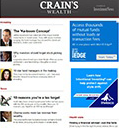If you're planning to fire up your grill in the backyard on Labor Day weekend, spare a moment to consider that you're partaking in a tradition in slow decline.
While two-thirds of U.S. households will likely barbecue outdoors over the next three days, according to market researcher Acosta Inc., other data show that, overall, al fresco home cooking is past its zenith, ending more than two decades of growth.
The percentage of U.S. homes using their barbecue grill for a main meal in a typical two-week period slipped to 35% last year from 40% in 2009, according to market researcher NPD Group Inc. Contributing factors include soaring beef prices and the Polar Vortex, which forced people indoors, said Darren Seifer, a New York-based food and beverage analyst at NPD.
Advertisement
Sirloin steak prices are up 12% in the past 12 months.
Another reason is shifting U.S. demographics, with more Hispanic and Asian consumers and a younger generation that craves bolder, international flavors, he said. Barbecue grill and smoker shipments in North America topped out in 2007 and have declined for three straight years through 2013, according to the most recent data from the Hearth, Patio & Barbecue Association.
“Barbecuing is not going away,” Mr. Seifer said in a telephone interview on Wednesday. “It's just that it's peaked.”
While backyard grilling has been in a downturn, people are eating more barbecued food outside the home. Sales at barbecue restaurants tracked by Technomic Inc. grew 7.3% last year.
Weber-Stephen Products LLC, the largest U.S. grill maker, says it doesn't see a slowdown. Customers are spending more when they buy grills and are barbecuing more throughout the year, said Kim Lefko, the Illinois company's executive vice president of marketing in the Americas.
As any meat eater who's been near a supermarket in the past few years will know, beef prices have climbed almost inexorably. Boneless sirloin steak reached a record $8.84 a pound in June, government data show, following a decline in the size of the U.S. cattle herd.
Steak now accounts for 21% of dinners on the grill at home, compared with 32% in 1985, and burgers are also less popular, according to NPD. Unsurprisingly, people have switched to cheaper meat. In July, consumers bought 15% more pork than a year earlier, according to the National Pork Board, an industry group encouraging grillers to choose chops over steak.
With wholesale pork prices down 16% from last year, supermarkets are also getting in on the act, said Altin Kalo, an analyst at Steiner Consulting Group in Manchester, New Hampshire.
“The availability has been there, and retailers could secure them at good price points and at nice margins,” Mr. Kalo said. “That seems to be the focus on Labor Day: More pork and less beef.”
In contrast to beef, pork-chop and chicken prices are down for the year. If you do shell out for pricey burgers, the cheese slices and the ice cream to follow will be cheaper this year as the global dairy industry deals with a supply glut.
In fact, overall, your Labor Day barbecue may cost less as supermarkets lure shoppers with good deals on meats, said John Anderson, deputy chief economist at the American Farm Bureau Federation.
“Around the cookout holidays, a lot of the expense is tied up in that centerpiece item which is whatever meat you're throwing on the grill. With pork and chicken, we've seen attractive prices for several months,” he said.






